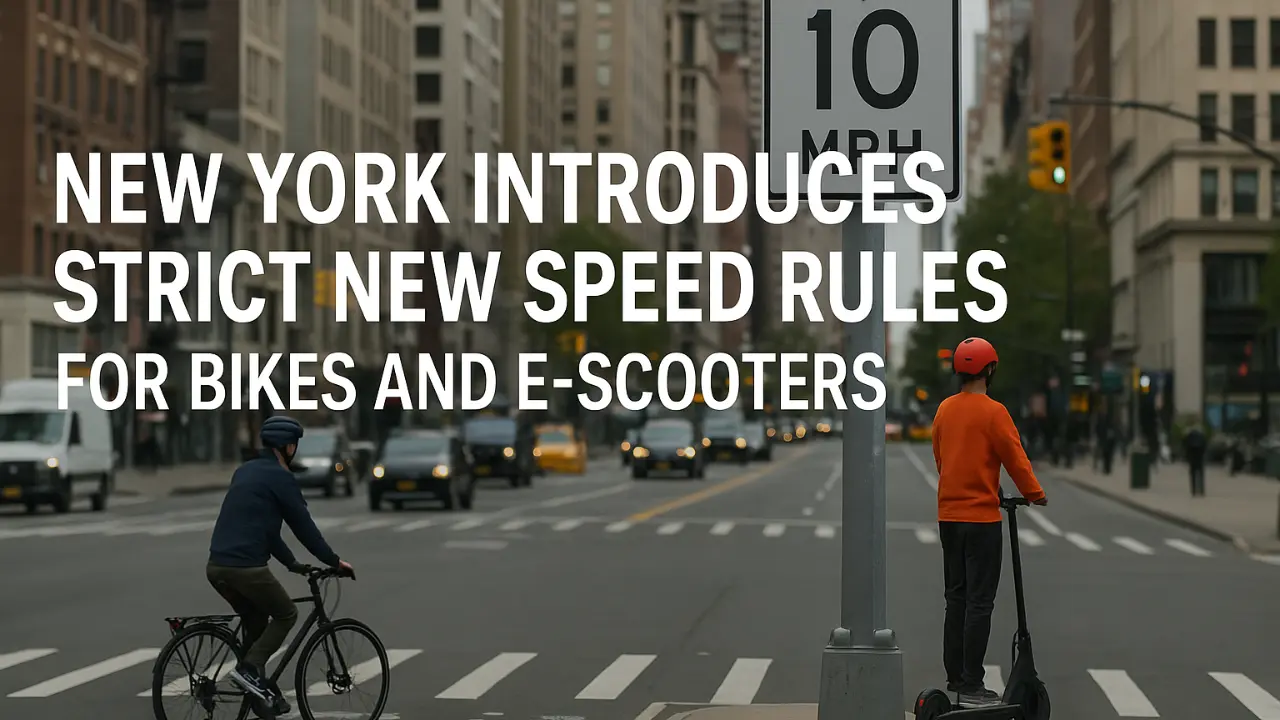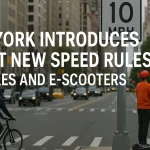New York has officially confirmed a sweeping update to its micro-mobility regulations, introducing strict new speed rules for bicycles and electric scooters across the state. The announcement comes after years of rising traffic congestion, growing e-scooter usage, and a surge in pedestrian safety concerns from local authorities, advocacy groups, and transportation planners. The new rules aim to balance rider freedom with public safety, addressing the rise of lightweight electric mobility that has transformed urban transportation.
Under these rules, speed limits are now standardized across many areas that previously had inconsistent or unclear restrictions. Cities like New York City, Albany, Rochester, Syracuse, and Buffalo have reported a significant rise in micro-mobility collisions since 2022, prompting lawmakers to push for clearer guidance. The updated regulations target both private riders and app-based rental services, with new penalties for violations, mandatory safety gear in some zones, and clearer enforcement strategies.
This long-form report breaks down everything riders need to know: new speed limits, where they apply, penalties, exceptions, enforcement updates, and how these rules may reshape the future of mobility in the state.
Why New York Updated Its Micro-Mobility Rules
New York officials say the changes were necessary due to expanding e-scooter usage, higher commuting speeds, and rising crash reports across dense neighborhoods.
Key factors driving the changes
-
Rapid growth of e-scooter ownership and rentals
-
Increased collisions involving pedestrians and cyclists
-
Confusion about speed rules due to inconsistent local ordinances
-
Pressure from community boards and traffic-safety groups
-
Rise in food-delivery riders traveling at high speeds
-
Evidence from DOT studies showing that speed plays a central role in crash severity
Recent data contributing to the decision
| Year | Estimated e-scooter & e-bike collisions statewide | Percent increase from prior year |
|---|---|---|
| 2021 | 1,470 | – |
| 2022 | 2,210 | +50% |
| 2023 | 3,020 | +36% |
| 2024 | 3,480 | +15% |
Transportation officials said that over 60% of severe injuries occurred at speeds above 18 mph. Studies also found that many riders believed the old rules were either vague or unenforceable, leading to inconsistent behavior on bike lanes, bridges, and shared paths.
Overview of the New Speed Rules
The new rules introduce uniform limits across different categories of micro-mobility. They distinguish between three primary groups:
-
Traditional pedal bicycles
-
Electric bicycles (Class 1, 2, and 3)
-
Electric scooters (privately owned and rental units)
Summary of speed limits under the new regulations
| Category | New max speed limit | Notes |
|---|---|---|
| Pedal bicycles | 15 mph | Applies to shared paths and most bike lanes |
| E-bikes (Class 1 & 2) | 20 mph | Includes throttle-assist and pedal-assist models |
| E-bikes (Class 3) | 25 mph | Only where allowed; restricted from certain paths |
| E-scooters | 15 mph | Applies statewide unless otherwise posted |
| Shared pedestrian-cycling zones | 10 mph | Strict enforcement in crowded areas |
| Parks & waterfront lanes | 10–12 mph | Speed changes depending on signage |
Officials emphasized that 25 mph is the absolute maximum for any micro-mobility device, and only Class 3 e-bikes under specific conditions may reach it.
Where the New Speed Limits Apply
The updated rules apply across the entire state, but enforcement will be strongest in:
-
Downtown business districts
-
Protected bike lanes
-
Multi-use trails
-
Parking lots and commercial zones
-
University campuses
-
High-density residential neighborhoods
-
Tourist zones such as Times Square, Niagara Falls, and Saratoga Springs
Special zones with extra restrictions
-
School zones: 10 mph limit during active hours
-
Bridges and tunnels: 12 mph cap unless signage indicates otherwise
-
Boardwalks: E-scooters may be banned depending on local rules
-
Transit hubs (subways, bus terminals, stations): walking speed only
Penalties Riders Will Face Under the New Law
The state has introduced a tiered penalty structure designed to encourage compliance rather than punishment, but repeat violators will face higher consequences.
Speeding penalty chart
| Violation | Penalty |
|---|---|
| Up to 5 mph over limit | Warning or $50 fine |
| 6–10 mph over limit | $100 fine |
| 11–15 mph over limit | $150 fine + possible safety course |
| 16+ mph over limit | $250 fine + device impound |
| Reckless riding | Up to $300 fine + appearance before traffic court |
| Tampering with speed limiter | $500 fine and device confiscation |
Penalties for businesses and delivery apps
Delivery companies and rental platforms must ensure their fleets comply with speed caps. Violations may result in:
-
Fines of up to $2,500 for repeated non-compliance
-
Temporary suspension of operating permits
-
Mandatory safety training for contracted riders
-
GPS-enabled monitoring reports submitted to the city
How Enforcement Will Work
Enforcement will be handled by local police departments, park rangers, traffic agents, and in some cases, DOT-authorized safety officers.
Key enforcement methods
-
Hand-held speed detection devices calibrated for micro-mobility speeds
-
Bike lane monitoring patrols during peak hours
-
Undercover safety inspectors in high-risk areas
-
Cameras capable of reading micro-mobility speeds in select districts
-
App-based speed regulation features required for rental scooters
GPS-enabled rental fleets must now automatically slow down when entering restricted zones, such as pedestrian plazas.
New Safety Requirements Introduced Alongside Speed Rules
The new regulations also mandate or recommend several safety measures.
Mandatory requirements
-
Front and rear lights on all e-scooters and e-bikes during nighttime
-
Helmets for all riders under 18
-
Helmets for Class 3 e-bike riders of all ages
-
Reflective gear for delivery riders operating after 7 p.m.
Recommended but not required
-
Mirror attachments
-
Bright or reflective clothing
-
Turn signals on handlebars
-
Side visibility reflectors
How the New Rules Impact Delivery Riders
Delivery workers make up one of the largest groups affected by the new regulations. New York’s delivery economy—powered by thousands of riders on e-bikes and e-scooters—has surged in recent years.
Understanding the changes
-
Speed limit for delivery bikes capped at 20 mph
-
Class 3 e-bikes cannot enter many park-based shortcuts
-
High-speed downhill riding subject to the same penalties
-
Food-delivery apps must verify riders’ bikes meet the new rules
-
Enhanced nighttime visibility rules apply to all delivery workers
Estimated impact on delivery times
| Delivery distance | Average time under old rules | Average time under new rules | Percent difference |
|---|---|---|---|
| 0.5 miles | 4–5 minutes | 5–6 minutes | +20% |
| 1 mile | 8–10 minutes | 10–12 minutes | +20–25% |
| 2 miles | 14–18 minutes | 16–20 minutes | +15% |
While travel times may slightly increase, officials argue that safer speeds reduce crash risk and costly injuries.
Impact on Rental Scooter Companies
Rental companies face some of the most significant adjustments.
Requirements for rental companies
-
GPS-linked speed caps
-
Automatic slowdown in restricted zones
-
Mandatory geofenced no-ride and no-park areas
-
User tutorials before first ride
-
Reporting crashes within 24 hours
-
Maintaining logs for any speed limiter tampering
Companies failing to meet these standards may lose operational licenses in certain cities.
Riders’ Reactions and Public Opinion
The public response has been mixed, with strong opinions on both sides.
Supporters argue
-
Slower speeds protect pedestrians
-
Bike lanes are safer with consistent rules
-
Delivery riders will face fewer injuries
-
Emergency rooms report fewer micro-mobility-related trauma cases when speeds are capped
-
New York’s dense sidewalks require stricter control
Critics argue
-
Slower speeds may discourage micro-mobility adoption
-
Delivery workers’ income may fall due to slower deliveries
-
Tourists unfamiliar with the rules may face fines
-
Enforcement could disproportionately affect immigrants and gig workers
-
Rural and suburban areas do not require such strict limits
Despite objections, state officials maintain that the long-term safety benefit outweighs the potential inconvenience.
How the New Rules Compare to Other Major Cities
New York’s updated policies align with global trends in micro-mobility regulation.
Comparison chart
| City | Max e-scooter speed | Special notes |
|---|---|---|
| New York | 15 mph | Strict enforcement in pedestrian zones |
| Washington, D.C. | 10 mph | Heavily geofenced areas |
| Los Angeles | 15–20 mph | Speed changes by district |
| London | 12.5 mph | Only rental scooters allowed |
| Paris | 12.5 mph | Private scooters heavily regulated |
| Singapore | 15 mph | Mandatory safety certification |
New York’s rules place it among the stricter global cities, especially regarding enforcement and penalties.
Exceptions and Special Cases
Certain exceptions allow for flexibility depending on location and rider needs.
Approved exceptions
-
Competitive cycling events with permits
-
Emergency e-bike responders under official duty
-
Adaptive mobility devices for people with disabilities
-
Designated high-speed cycling tracks in parks
These exceptions must be pre-approved by city or state authorities.
Advice for Riders to Stay Compliant
Transportation safety experts recommend several steps to adapt quickly to the new regulations.
Key tips
-
Check posted signs frequently
-
Install a speedometer or mobile app to track speed
-
Avoid tampering with speed limiters
-
Use lower-power modes in crowded areas
-
Wear reflective gear when riding at night
-
Slow down before entering bridges or shared paths
-
Update e-scooter firmware to ensure proper speed capping
Riders who adapt early will avoid penalties and contribute to safer roads.
How the Rules Might Affect Future Urban Transportation
The new speed rules are expected to shape future infrastructure planning across the state.
Anticipated outcomes
-
More protected bike lanes designed for 15–20 mph traffic
-
Additional micro-mobility parking hubs
-
Greater separation between pedestrian and micro-mobility lanes
-
Increased investments in urban cycling infrastructure
-
New state-funded educational campaigns on safe micro-mobility
New York officials also hinted at a future certification system for high-speed electric micro-mobility devices, similar to motor-scooter licensing.
Conclusion
New York’s strict new speed rules for bicycles and e-scooters mark a major shift in how the state approaches micro-mobility safety. Designed to address rising collisions and protect pedestrians, the regulations introduce standardized limits, stronger enforcement, and clearer guidance for all types of riders. Although the changes have sparked debate—particularly among delivery workers and frequent riders—state officials believe the long-term benefits justify the move.
Riders can expect safer bike lanes, better-organized traffic flow, and more consistent rules across cities. While adjusting to the new limits may take time, staying informed and riding responsibly will help ensure that micro-mobility continues to thrive safely in New York’s evolving transportation landscape.






Leave a Comment